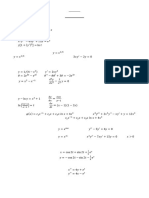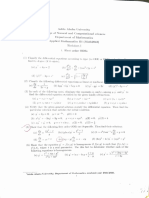0 ratings0% found this document useful (0 votes)
51 viewsProblem Set 4
This document contains a 6-part problem set on differential equations. It includes:
1) Finding the differential equation of two families of curves.
2) Showing that two functions have a Wronskian of zero but are not linearly dependent.
3) Finding the general solution to a differential equation that has one known solution.
4) Determining values of α and β that satisfy a given differential equation.
5) Solving three differential equations by directly computing derivatives.
6) Transforming a differential equation into one with constant coefficients and solving for a specific equation.
Uploaded by
LEGENDARY uploaderCopyright
© © All Rights Reserved
Available Formats
Download as PDF, TXT or read online on Scribd
0 ratings0% found this document useful (0 votes)
51 viewsProblem Set 4
This document contains a 6-part problem set on differential equations. It includes:
1) Finding the differential equation of two families of curves.
2) Showing that two functions have a Wronskian of zero but are not linearly dependent.
3) Finding the general solution to a differential equation that has one known solution.
4) Determining values of α and β that satisfy a given differential equation.
5) Solving three differential equations by directly computing derivatives.
6) Transforming a differential equation into one with constant coefficients and solving for a specific equation.
Uploaded by
LEGENDARY uploaderCopyright
© © All Rights Reserved
Available Formats
Download as PDF, TXT or read online on Scribd
You are on page 1/ 1
IIITDM KANCHEEPURAM
MA1001 Differential Equations
Problem Set 4
1. By eliminating the constants c1 and c2 , find the differential equation of each the fol-
lowing 2-parameter families of curves:
(a) y = c1 x + c2 x2 ; (b) y = c1 x + c2 sin x.
2. Consider the functions f (x) = x3 and g(x) = x2 |x| on the interval [−1, 1].
(a) Show that their Wronskian is identically zero on [−1, 1].
(b) Show that f (x) and g(x) are not linearly dependent.
(c) Do (a) and (b) contradict a result (figure out the result and state it) known to
you? If not, why not?
−1
3. The equation (1 − x2 )y 00 − xy 0 − a2 y = 0 has y = ea sin x
as one solution. Find the
general solution.
2
4. y = e−x is a solution of the differential equation xy 00 + αy 0 + βx3 y = 0 for some real
numbers α and β. Find α and β.
5. Solve the following differential equations:
d4 y d2 y d4 y d4 y
(a) 4 − 2 = 0; (b) 4 − y = 0; (c) 4 + y = 0.
dx dx dx dx
6. The equation x2 y 00 + pxy 0 + qy = 0 is called Euler’s equidimensional equation. Show
that the change of independent variable given by x = ez transforms it into an equation
with constant coefficients. Apply this technique to find the general solution of x2 y 00 +
3xy 0 + 10y = 0.
You might also like
- MA2020 Differential Equations (July - November 2014) Assignment Sheet-1 (Covering Quiz-I Syllabus)No ratings yetMA2020 Differential Equations (July - November 2014) Assignment Sheet-1 (Covering Quiz-I Syllabus)2 pages
- 2nd Order Differential Equations QuestionsNo ratings yet2nd Order Differential Equations Questions21 pages
- Es 208 Differential Equations: University of Science and Technology of Southern PhilippinesNo ratings yetEs 208 Differential Equations: University of Science and Technology of Southern Philippines65 pages
- 2nd Order Differential Equations SubstitutionsNo ratings yet2nd Order Differential Equations Substitutions24 pages
- Exercises: Initial-Value and Boundary-Value ProblemsNo ratings yetExercises: Initial-Value and Boundary-Value Problems2 pages
- 2nd Order Differential Equations Exam QuestionsNo ratings yet2nd Order Differential Equations Exam Questions29 pages
- First Order Ordinary Differentiation EquationsNo ratings yetFirst Order Ordinary Differentiation Equations25 pages
- 1st Order Differential Equations Exam Questions100% (1)1st Order Differential Equations Exam Questions27 pages
- NIIT University MAT 101 Tutorial Sheet 2 Differential Equations AnswersNo ratings yetNIIT University MAT 101 Tutorial Sheet 2 Differential Equations Answers2 pages
- ODE Mathematics Optional Previous YearsNo ratings yetODE Mathematics Optional Previous Years12 pages
- Differential Equations Module (Chapter 1) - 1100% (1)Differential Equations Module (Chapter 1) - 18 pages
- Differential Equation DPP 03 of Lec 04 Prayas JEE 2 0 2025No ratings yetDifferential Equation DPP 03 of Lec 04 Prayas JEE 2 0 20253 pages
- Mathematics 1St First Order Linear Differential Equations 2Nd Second Order Linear Differential Equations Laplace Fourier Bessel MathematicsFrom EverandMathematics 1St First Order Linear Differential Equations 2Nd Second Order Linear Differential Equations Laplace Fourier Bessel MathematicsNo ratings yet
- The Reflection Method For The NumericalNo ratings yetThe Reflection Method For The Numerical15 pages
- Water Purification - Low Temperature DesalinationNo ratings yetWater Purification - Low Temperature Desalination10 pages
































































